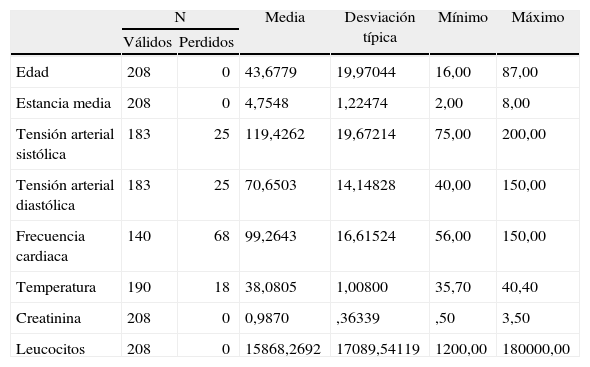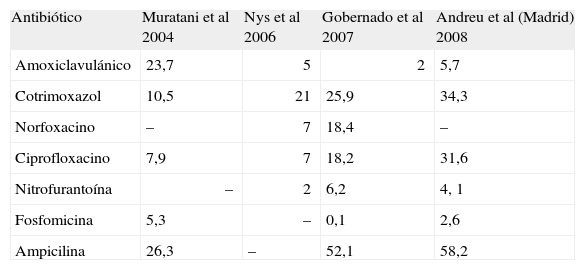Analizar las características epidemiológicas de la población ingresada por pielonefritis aguda en una unidad de corta estancia (UCE) durante el año 2005. Describir y analizar los aspectos microbiológicos registrados en estas infecciones y su implicación clínica.
Material y métodoSe realizó un estudio retrospectivo de una cohorte de 208 pacientes que ingresaron durante el año 2005 en la UCE de nuestro centro a consecuencia de una pielonefritis aguda (PNA). Se incluyeron datos epidemiológicos, clínicos y microbiológicos. Análisis estadístico: SPSS v.14.0.
ResultadosSe incluyeron 208 pacientes, siendo el 74% mujeres, con una edad media de 43,6 (16-87). La estancia media fue de 4,7 ± 1,2 días. El 96,6% fueron dados de alta con éxito desde la UCE. El urocultivo se consideró válido en 173 pacientes, siendo positivo el 51,4%. Escherichia coli representó el 93,2% de los patógenos aislados en la orina. Los hemocultivos válidos fueron 178, siendo positivos en 37 pacientes. E. coli se aisló en el 64,8% de ellos. De las resistencias a antibióticos analizadas para E. coli en urocultivo, el 68,7% fueron para ampicilina; 22,9% para cotrimoxazol; 18,1% para ciprofloxacino; 16,9% para amoxicilina-clavulánico y el 2,4% para fosfomicina. Siete pacientes fueron trasladados a hospitalización domiciliaria y no hubo ningún fallecimiento.
ConclusionesLa pielonefritis aguda con criterios de ingreso puede manejarse con éxito en una UCE según las recomendaciones terapéuticas vigentes en nuestro medio, en función de los datos microbiológicos registrados y la baja incidencia de complicaciones.
To analyze the epidemiological characteristics of the population admitted to a short-stay medical unit (SSMU) during 2005 due to acute pyelonephritis. To describe and analyze microbiological aspects recorded in these infections and their clinical implication.
Material and methodA retrospective study was carried out in a cohort of 208 patients admitted in the SSMU during 2005 because of acute pyelonephritis. Epidemiological, clinical and microbiological data were collected. The statistical analysis was done with the SPSS v. 14.0.
Results208 patients were included, 74% of whom were females. Average age was 43.6 (16-87). Mean length of stay was 4.7±1.2 days and 96.6% of patients were discharged successfully from SSMU. Urine culture was valid in 173 patients, 51.4% of which were positive. Escherichia coli was isolated in 93.2% of urine cultures. Blood cultures were valid in 178 cases and in 37 of which were positive. E. coli was isolated in 64.8% of these. In E. coli urine samples, resistance rate to ampicillin was 68.7%, to co-trimoxazole 22.9%, to ciprofloxacin 18.1%; to amoxicillin/clavulanic acid 16.9% and to fosfomycin 2.4. Seven patients were transferred to hospital home care, there being no deaths.
ConclusionsAcute pyelonephritis with admission criteria can be managed successfully in the SSMU with the applicable therapeutics guidelines with regard to the most common microbiological aspects registered and the low incidence of complications.
Article
Diríjase desde aquí a la web de la >>>FESEMI<<< e inicie sesión mediante el formulario que se encuentra en la barra superior, pulsando sobre el candado.

Una vez autentificado, en la misma web de FESEMI, en el menú superior, elija la opción deseada.

>>>FESEMI<<<










